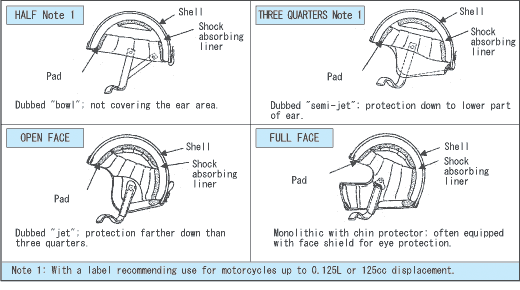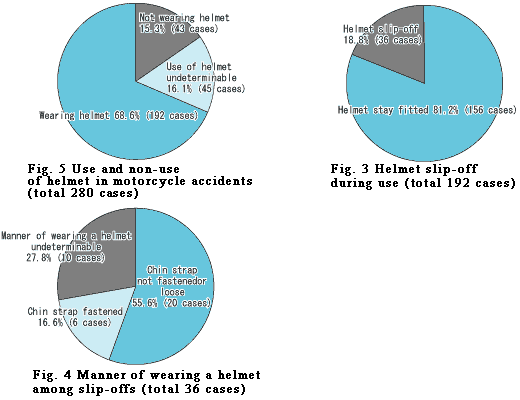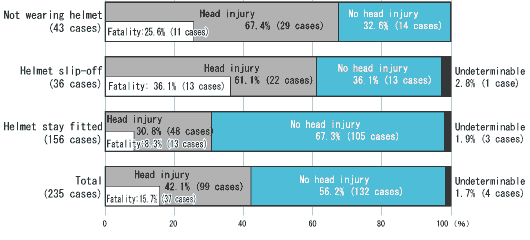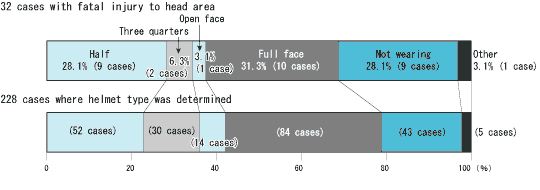 |
||||
|
|||||||
 |
| Helmets for motorcycle occupants can be divided into the four types illustrated below. Two of the four types in the market are affixed with a label recommending use for smaller motorcycles up to 0.125L (125cc) in engine displacement. |
 Fig. 1 Helmet types and structure (cross-section) |
| UP |
 |
| Helmets are expected to protect motorcycle occupants from head injury, but head protection cannot be fully achieved unless the helmet is worn correctly. This section reviews the relationship between the use of helmets and injuries to motorcycle occupants. |
| 2.1. Helmet Wearing Ratio and Slip-off |
| A total of 280 motorcycle accidents that occurred in the Tsukuba City area were investigated by ITARDA from 1993. The following graphs are produced from the data collected by ITARDA. Figure 2 is about the percentage of motorcyclists wearing a helmet, Figure 3 about the frequency of helmet slip-off, and Figure 4 about the manner of wearing a helmet. |
 |
| According to Figures 2 and 3, a helmet was not worn in 15.3% of 280 motorcycle accidents. Among the remaining 192 helmet wearing cases, 18.8% indicated that the helmet slipped off from the head during an accident. These percentage figures were much larger than the helmet non-wearing ratio of 2.0% and the helmet slip-off ratio of 8.0% recorded in 2001 statistics. In Figure 4, the manner of wearing a helmet was investigated among the 36 helmet slip-off cases. It was found that in 55.6% of the helmet slip-off cases the chin strap either was not fastened or was fastened loosely. These data suggest that the primary cause of helmet slip-off during an accident is the failure to fasten the chin strap correctly. Without correct fastening of the chin strap, the helmet cannot be fully protective. But there are six cases in which the helmet fell off although the chin strap was correctly fastened. It was found: in five of the six cases the helmet was the half type that does not cover the ear area (helmet type undeterminable in the remaining case). Three of the five half type helmets fell off after impact, and the remaining two before or without impact. The following may explain why half type helmets are more prone to fall off:
|
| 2.2. Helmet Slip-off and Head Injury |
| Of the total 280 motorcycle accident cases investigated, the 235 cases with a clear record of helmet use or non-use were selected to analyze the relationship between helmet slip-off and head injury. Results are summarized in Figure 5. |
 Fig. 5 Helmet slip-off and head injury |
| Head injury occurred in 67.4% of cases where the motorcyclist did not put on a helmet. On the other hand the corresponding head injury ratio was much lower at 30.8% in the cases where the helmet stayed fitted during the accident. The head protective effect of wearing a helmet is therefore very clear. The bar graphs also show that, if the helmet falls off during an accident, the risk of head injury climbs about 2 times and the risk of fatality 4 times over the cases where the helmet stays fitted. To prevent the helmet from slipping off, the chin strap must be fastened firmly. |
| UP |
 |
| Analysis was performed on the relationship between helmet types and injury conditions, selecting the 228 cases where the helmet type was determinable. Of these cases, injury to the "head area" (head, neck and face) was recorded in 82 cases including 32 fatal accidents. The upper bar graph in Figure 6 divides the fatal accidents in terms of helmet types.
|
 Fig. 6 Helmet types and injury |
| Analysis has found a tendency of half type helmets to be more vulnerable to serious injury to the head area. Half type and three quarters type helmets are made for smaller motorcycles up to 0.125L (125cc) or the two-wheeled vehicles categorized as mopeds 1st class and 2nd class. But there are cases where the occupant of a larger motorcycle mistakenly wear a half or three quarters type helmet. Serious injury to the head area can be reduced by selecting an appropriate type of helmet.
|
| UP |
Institute for Traffic Accident Research and Data Analysis (ITARDA) |